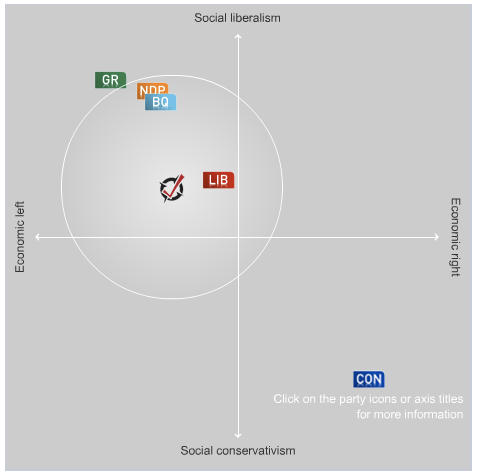CBC has recently released its VOTE COMPASS, a survey involving 30 questions to see where one aligns politically. The questionnaire was developed by a team of elections researchers and political scientists in conjunction with the University of Toronto. The Vote Compass has in its first week open to the public via the CBC website been often used, though still under scrutiny for a perceived Liberal bias. Both the National Post and Toronto Sun have cited Queen’s University professor Kathy Brock’s finding that the online tool is flawed a skewed in favour of the Liberals. While the questions can be answered on a scale of ‘strongly agree’ to ‘strongly disagree,’ those who find themselves without polarizing opinions tend to align closer to the Liberal centre. Meanwhile, many NPD voters are finding themselves aligning closer to the Green Party, a ploy perhaps to improve Liberal chances in NDP ridings according to some critics.
Meanwhile, Vote Compass executive director Clifton van der Linden has maintained that the online form is “not meant to tell people how to vote,” but rather is a tool to promote discussion and raise awareness of the views of political parties. In that, the Vote Compass has succeeded. What strikes me, however, is where the 5 major parties lie on the four-quadrant grid dividing “economic right” with “economic left,” and “social liberalism,” from “social conservatism.
On the far right of the economic spectrum, as expected, is the Conservative Party, alone. The Liberals fall essentially right in the middle of the grid. Then there’s the Bloc Quebecois, the NDP, and the Green Party, all of them socially liberal and economically left. The way the questionnaire is set up, one slightly different answer could sway a left-wing voter from NPD to the Green Party, and the Bloc is fairly close too with the only main political difference being their fight for sovereignty. My question is, in a first-past-the-post electoral system, why would these final three parties that are so similarly aligned split their popular vote?
I am no fan of the current electoral system, and truly believe that proportional representation is the only fair means. It is not fair for the Green Party to have almost 5% of the popular vote in the 2008 election, and zero representation in the House of Commons. The reality is, however, that we have to succeed under the current system, and that’s by beating everyone else in an individual riding.
While critics are claiming that the Vote Compass is trying to draw sway traditional NDP voters to the Green, thus helping the Liberals in many ridings, a real tactic from the Greens and NPD parties should be showing the public where they actually differ. And if the differences are not drastic, they’d be wise to amalgamate in the same way the Canadian Alliance and Conservative Party did years ago in paving the way for a right-wing government.
In the larger scope of things, the Vote Compass is a great tool. It tells us where we currently align in terms of politics based on what issues are important to us. However, instead of merely telling us what party we should favour most, it’d be smart to explain to us why we should favour these parties. Tell us why the traditional NPD voters might be more inclined to like a Green Party member by showing us the platform the Green Party has. When asking us if we believe we should spend more money on protecting our Arctic sovereignty, tell us first how much we are already spending on this battle to begin with. The Vote Compass is a great tool to show us where we stand, but considering how Canadians are considered not politically informed enough, this is a great chance for us to learn about where every party stands.
aa.


No comments:
Post a Comment